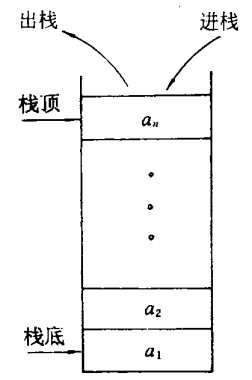栈
栈(stack)是限定仅在表尾进行插入和删除操作的线性表。
表尾被称为栈顶(top),表头被称为栈底(bottom)
栈有两种存储方式:①顺序栈 ②链栈
栈示意图

进栈顺序与出栈顺序相反,后进先出(LIFO)
顺序栈
一、概念
顺序栈的存储空间是动态分配出来的一块空间,这块空间使用数组来表示
二、图解

三、参考源码
头文件
#include <stdio.h>
#include <stdlib.h>
#include <assert.h>
#include <stdbool.h>
栈结构定义
/*************************************************************/
//定义常量
#define DEFAULT_STACK_CAPACITY 8 //初始化容量
#define DEFAULT_STACK_GROW_MULTIPLE 2 //扩容倍数
typedef int ET;
/*************************************************************/
//顺序栈
typedef struct SeqStack
{
ET* base;
size_t capacity; //当前最大容量
int top; //当前栈顶位置
}SeqStack;
方法声明
void SeqStackInitial(SeqStack* p, size_t cap); //初始化顺序栈结构
bool IsEmpty(SeqStack* p); //判断顺序栈是否为空
bool IsFull(SeqStack* p); //判断顺序栈是否为满
void SeqStackGrow(SeqStack* p); //栈满之后扩容栈结构
void SeqStackAddTop(SeqStack* p, ET val); //入栈
void SeqStackShowData(SeqStack* p); //展示栈中的数据
void SeqStackDeleteTop(SeqStack* p); //出栈
ET SeqStackGetTop(SeqStack* p); //获取栈顶元素
int SeqStackGetSize(SeqStack* p); //获取顺序栈当前大小
int SeqStackGetCapacity(SeqStack* p); //获取顺序栈当前最大容量大小
void SeqStackDestroy(SeqStack* p); //摧毁顺序栈结构
void SeqStackClear(SeqStack* p); //清空栈中的数据
方法实现
void SeqStackInitial(SeqStack* p, size_t cap){
assert(p != NULL);
p->capacity = cap > DEFAULT_STACK_CAPACITY ? cap : DEFAULT_STACK_CAPACITY;
p->top = 0;
p->base = (ET*)malloc(sizeof(ET)* p->capacity);
}
bool IsEmpty(SeqStack* p){
assert(p != NULL);
return p->top == 0;
}
bool IsFull(SeqStack* p){
assert(p != NULL);
return p->top == p->capacity;
}
void SeqStackGrow(SeqStack* p){
assert(p != NULL);
p->capacity *= DEFAULT_STACK_GROW_MULTIPLE;
ET* new_base = (ET*)realloc(p->base, sizeof(ET)* p->capacity);
p->base = new_base;
}
void SeqStackAddTop(SeqStack* p, ET val){
assert(p != NULL);
if (IsFull(p)){
SeqStackGrow(p);
}
p->base[p->top++] = val;
}
void SeqStackShowData(SeqStack* p){
assert(p != NULL);
if (IsEmpty(p)){
printf("空表!\n");
return;
}
int index = p->top - 1;
while (index >= 0){
printf("%2d|%2d|\n", index, p->base[index]);
index--;
}
printf(" |__|\n");
}
void SeqStackDeleteTop(SeqStack* p){
assert(p != NULL);
if (IsEmpty(p)){
printf("空表!\n");
return;
}
p->top--;
}
ET SeqStackGetTop(SeqStack* p){
assert(p != NULL);
if (IsEmpty(p)){
printf("空表!\n");
return;
}
return p->base[p->top - 1];
}
int SeqStackGetSize(SeqStack* p){
assert(p != NULL);
if (IsEmpty(p)){
printf("空表!\n");
return;
}
return p->top;
}
int SeqStackGetCapacity(SeqStack* p){
assert(p != NULL);
if (IsEmpty(p)){
printf("空表!\n");
return;
}
return p->capacity;
}
void SeqStackDestroy(SeqStack* p){
assert(p != NULL);
p->capacity = DEFAULT_STACK_CAPACITY;
p->top = 0;
free(p->base);
p->base = NULL;
}
void SeqStackClear(SeqStack* p){
p->capacity = DEFAULT_STACK_CAPACITY;
p->top = 0;
}
链栈
一、概念
链栈的存储空间是动态分配的结点,这个结点由数据域和指针域组成,并且只能在栈顶处增加或删除结点
二、图解

三、参考源码
头文件
#include <stdio.h>
#include <stdlib.h>
#include <assert.h>
#include <stdbool.h>
定义链栈结构
/*************************************************************/
//定义常量
typedef int ET;
/*************************************************************/
//链栈
typedef struct StackNode{
ET data;
struct StackNode* next;
}StackNode;
typedef StackNode* LinkStack;
方法声明
void LinkedStackInitial(LinkStack *pst); //初始化链栈结构
StackNode* GetNode(ET val); //创建并返回一个栈结点
void LinkedStackAddTop(LinkStack *pst, ET val); //入栈
void LinkedStackDeletePop(LinkStack *pst); //出栈
ET LinkedStackGetTop(LinkStack *pst); //获取栈顶结点
void LinkedStackShowData(LinkStack *pst); //展示链栈中数据
int LinkedStackGetLength(LinkStack *pst); //获取栈的大小
void LinkedStackDestroy(LinkStack *pst); //摧毁栈结构
方法实现
void LinkedStackInitial(LinkStack *pst){
assert(pst != NULL);
*pst = NULL;
}
StackNode* GetNode(ET val){
//申请结点
StackNode* s = (StackNode*)malloc(sizeof(StackNode));
assert(s != NULL);
s->data = val;
s->next = NULL;
return s;
}
void LinkedStackAddTop(LinkStack *pst, ET val){
assert(pst != NULL);
StackNode* s = GetNode(val);
if (*pst == NULL){
//空栈
*pst = s;
}
else{
//栈非空
StackNode* temp = *pst;
while (temp->next != NULL){
temp = temp->next;
}
temp->next = s;
}
}
void LinkedStackDeletePop(LinkStack *pst){
assert(pst != NULL);
if (*pst == NULL){
//空栈
printf("空栈!\n");
return;
}
else{
//栈非空
StackNode* temp = *pst;
if (temp->next == NULL){
//栈只有一个元素
free(temp);
*pst = NULL;
}
else{
//栈中有多个元素
while (temp->next->next != NULL){
temp = temp->next;
}
StackNode* p = temp->next;
free(p);
temp->next = NULL;
}
}
}
ET LinkedStackGetTop(LinkStack *pst){
assert(pst != NULL);
if (*pst == NULL){
//空栈
printf("空栈!\n");
return -1;
}
else{
//栈非空
StackNode* temp = *pst;
if (temp->next == NULL){
//栈只有一个元素
return temp->data;
}
else{
//栈中有多个元素
while (temp->next->next != NULL){
temp = temp->next;
}
StackNode* p = temp->next;
return p->data;
}
}
}
void LinkedStackShowData(LinkStack *pst){
assert(pst != NULL);
if (*pst == NULL){
//空栈
printf("空栈!\n");
}
else{
//栈非空
StackNode* temp = *pst;
printf(" |==|\n");
int i = 0;
while (temp->next != NULL){
printf("%2d|%2d|\n", i, temp->data);
printf(" |↓|\n");
temp = temp->next;
i++;
}
printf("%2d|%2d|\n", i, temp->data);
}
}
int LinkedStackGetLength(LinkStack *pst){
assert(pst != NULL);
int len = 1;
if (*pst == NULL){
len = 0;
}
else{
StackNode* p = *pst;
while (p->next != NULL){
p = p->next;
len++;
}
}
return len;
}
void LinkedStackDestroy(LinkStack *pst){
assert(pst != NULL);
if (*pst == NULL){
return;
}
else{
StackNode* p = *pst;
StackNode* q = *pst;
while (q != NULL){
q = q->next;
free(p);
p = q;
}
}
*pst = NULL;
}